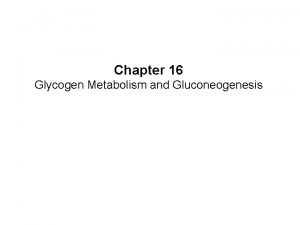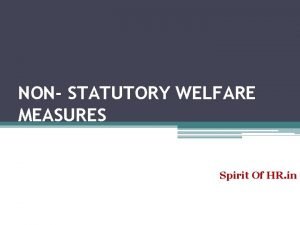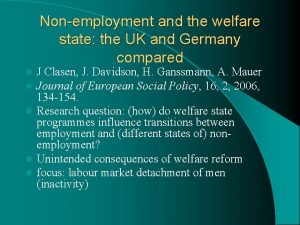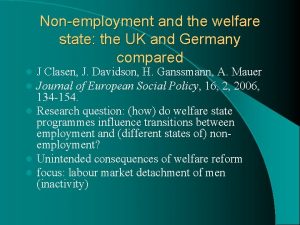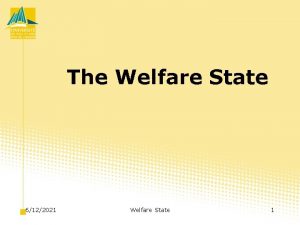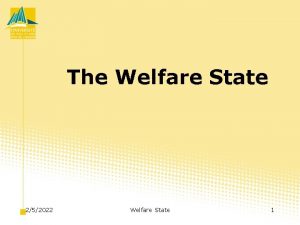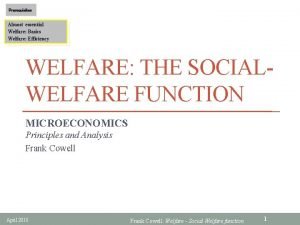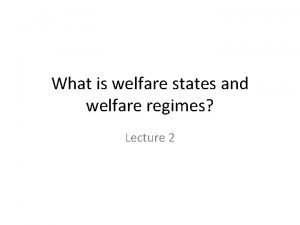Nonemployment and the welfare state the UK and



















- Slides: 19

Non-employment and the welfare state: the UK and Germany compared J Clasen, J. Davidson, H. Ganssmann, A. Mauer Journal of European Social Policy, 16, 2, 2006, 134 -154. l Research question: (how) do welfare state programmes influence transitions between employment and (different states of) nonemployment? l Unintended consequences of welfare reform l focus: labour market detachment of men (inactivity) l l


population working-age population non-workingage population inactive Econom. active employed unemploy ed family work nonemployed education early retired sick/ disabled something else



Number of claims and average duration of claims for Invalidity/Incapacity benefit male claimants (thousands) 1990 1992 1994 1996 1998 2000 2002 1, 085. 8 1, 372. 1 1, 544. 4 1, 672. 5 1, 551. 6 1, 391. 5 1, 468. 0 4, 01 3, 96 4, 71 4, 92 5, 24 5, 64 5, 90



Influences on labour market transitions l Skill, health, age l Business cycle l Local/regional labour market conditions l Employment history (type of job, duration, unemployment spells) l Household (partner has a job? ) l (changes in) benefit system

Major welfare state changes in the UK l 1995 Incapacity for Work Act – – From Invalidity to Incapacity benefit Stricter work (medical) test Less generous and benefit taxable Higher rate starts later (after 12 months; previously 6) – Hypothesis: fewer transitions into long-term sickness (or inactivity in general), perhaps: from employment to unemployment first (and then sickness? ); re-routed path to inactivity?

Major welfare state reform legislation UK l Jobseeker Allowance (JSA) in 1996 – – shorter unemployment insurance period (6 months) Stricter (availability for) work test Jobseekers contract Interaction with occupational pension – Hypothesis: fewer flows from employment to unemployment; redundant workers (especially those with occupational pension) might move into inactivity rather than unemployment

Data l BHPS and GSOEP (employment history files; event history; discrete time hazard models) l 1991 -2001 l Time related dummies for IWA, JSA; business cycles

Co-variates l Educational attainment l Ethnic background (non-white) l Household situation l Individual employment history l Dummies to control for seam effects, time dependence and over-sampled regions (BHPS) l Two age groups (25 -49; 50 -64)

l Summary tables for estimates of transitions: from employment into non-e generally, and different states of non-employment (unemployment, long-term-sickness, retired/something else) l See handouts

Results of micro-data hazard models l Younger age group l Effect of economic recovery (after 93): – 1 – as expected – 2 – but more transitions form unemployment to inactivity l Effect of IWA: – 3 – from inactivity into employment more likely l Effect of JSA: – 4 A – fewer moves from employment to unemployment – 4 B – no effect on moves out of un/non-employment into employment – 4 C – positive effect on moves from employment into inactivity

Results of micro-data hazard models l Older age group l Effect of economic recovery (after 93) – 1 A – reduced transitions into unemployment l Effect of JSA – 1 B – reduced transitions into unemployment – 2 – did not promote inactivity (in contrast to younger group) l Effect of IWA – 3 A – fewer moves from employment to unemployment – 3 B – and fewer moves from employment to inactivity – 3 C – positive effect on moves from unemployment into inactivity

A little more detail on inactivity l Younger age group l Effect of JSA – 5 - more transitions into something else (no such effects of economic recovery or IWA) l >> the JSA promoted inactivity amongst prime-aged men out of work l l Older workers Effect of IWA – 6 – increased moves from unemployment into lt sickness – 7 – decreased moves from employment into lt sickness (changing pathways? )

General results Some comparative insights into transitions in and out of inactivity l Some insights into the effect of welfare state legislation on moves in and out of employment and (various states of) non-employment l Declining unemployment in the UK after 1993 due to labour market improvement, and stronger disincentives to become unemployed after losing a job l JSA has contributed to labour market detachment of prime-aged men (but not older workers) l

Problems with event history analysis as employed here l Left censoring (covariate information only in ‘survey time’; overestimating employment durations) l Truncation l Time-dependence (model assumes independence of episode survival times) l Unobserved heterogeneity
 Pros and cons of welfare state
Pros and cons of welfare state Family and morale welfare and recreation
Family and morale welfare and recreation Good state and bad state graphs
Good state and bad state graphs Absorptive state vs postabsorptive state
Absorptive state vs postabsorptive state Types of glycogen storage disease table
Types of glycogen storage disease table Zczc state graph
Zczc state graph Voluntary health and welfare organization examples
Voluntary health and welfare organization examples National program related to child health
National program related to child health National policies related to child health and welfare
National policies related to child health and welfare Pros and cons of welfare
Pros and cons of welfare R.a 9344
R.a 9344 Care welfare safety and security
Care welfare safety and security Voluntary health agencies
Voluntary health agencies District integrated health and family welfare society
District integrated health and family welfare society Animal welfare continuum
Animal welfare continuum Agriculture cooperation and farmers welfare
Agriculture cooperation and farmers welfare Statutory and non statutory welfare measures
Statutory and non statutory welfare measures Venn diagram for plant and animal cells
Venn diagram for plant and animal cells Ethics and social welfare
Ethics and social welfare Animal rights versus animal welfare
Animal rights versus animal welfare




